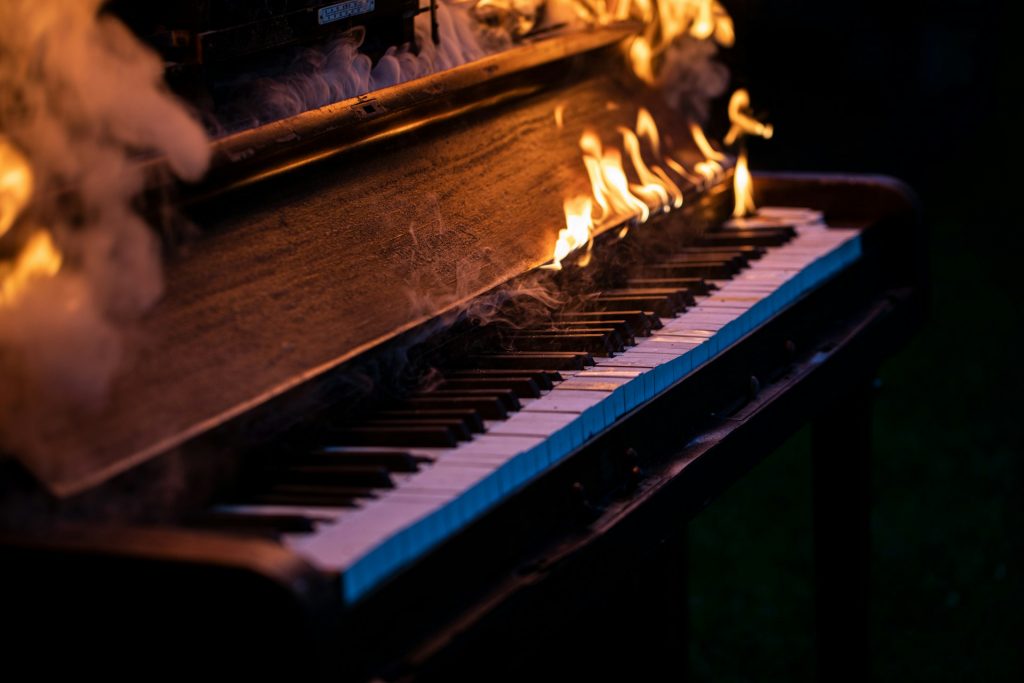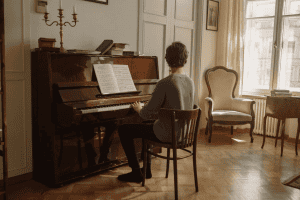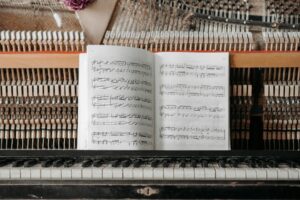Many beginner pianists wonder ‘what is the hardest song to play on piano’? The truth is, if you ask 10 pianists, you might get 10 different answers!
From rock to pop to classical to soul and RnB, we have compiled this list of 10 of the hardest songs to play on piano. Whether you favor the rhapsodic passages of composers like Ravel, the enigmatic intricacies of Scriabin, or the powerful chord work of Alicia Keys, each of these 10 songs offers a worthy challenge to pianists everywhere. Read on and discover 10 of the hardest piano songs to play!
- Fall in love with the music - Learn your favorite songs, at a level suitable for you.
- Enjoy interactive piano lessons - Explore courses covering music theory, technique chords & more.
- Get real-time feedback - Skoove's feedback tells you what went well and what needs practice.

Queen – “Bohemian Rhapsody”
Bohemian Rhapsody, a magnum opus by Queen, stands as a musical enigma and a challenging piece for pianists. Its structural complexity, characterized by distinct sections ranging from ballads to hard rock, demands a seamless transition between diverse musical styles. Intricate vocal harmonies, notably in the operatic sections, add a layer of difficulty, while Freddie Mercury’s virtuosic piano parts, featuring rapid arpeggios and dynamic shifts, test the technical skill of pianists.
Learn how to play ‘Bohemian Rhapsody’ by Queen. Start a 7 day trial today – no card details required!
Liszt – “La Campanella” (Paganini Etude No. 3)
Liszt’s La Campanella, the third of his six Paganini Etudes, stands as a pinnacle of virtuosity amongclassical piano songs. The composition is inspired by Niccolò Paganini’s violin piece and Liszt’s piano adaptation is marked by rapid octave passages, intricate fingerwork and a relentless tempo. Renowned for its technical challenges, this work demands extraordinary precision and agility from the pianist. Successfully navigating the challenges of ‘La Campanella’ is a testament to a pianist’s mastery of piano technique and musicality, making it a celebrated but formidable entry into the repertoire.
Billy Joel – “Prelude/Angry Young Man”
Billy Joel’s Prelude/Angry Young Man is a dynamic showcase of rock-infused piano virtuosity. A challenging piece that blends classical elements with Joel’s signature rock style.
The complexity of this composition lies in its rapid,syncopated rhythms, intricate hand coordination and dramatic shifts in dynamics. Prelude/Angry Young Man requires not only agility but also a keen sense of expression to convey the emotional intensity embedded in Joel’s musical narrative.
Chopin –“Nocturne in E Flat Major“
Chopin’s Nocturne in E Flat Major stands as a jewel in the crown of the composer’s lyrical and intimate piano works. Renowned for its exquisite beauty and emotional depth, this Nocturne is a delicate yet demanding piece that requires a pianist’s nuanced touch and sensitivity.
With its gracefully arpeggiated chords, intricate ornamentation and tender melodies, the Nocturne unfolds like a poetic reverie. Chopin’s characteristic use of rubato and expressive phrasing challenges the performer to convey a sense of spontaneity and heartfelt emotion. It is a great piece to learn as you develop and progress with learning how to play piano.
Learn how to play ‘Nocturne in E Flat Major’ on piano. Start a 7 day trial today – no card details required!
Rachmaninoff – “Piano Concerto No. 3 in D minor”
Rachmaninoff’s Piano Concerto No. 3 in D minor stands as a titan in the realm of piano concertos, renowned for its sheer technical demands and emotional depth. Comprising three movements, this concerto unfolds with a relentless virtuosity that requires the utmost skill from the pianist. It is one of the hardest songs to play on the piano.
The intricate fingerwork, sweeping arpeggios and rapid octave passages epitomize Rachmaninoff’s signature style. Beyond the technical challenges, the concerto demands a profound understanding of musical expression to convey the rich emotional tapestry embedded in its grandeur.
Alicia Keys – “Fallin’”
Alicia Keys’ Fallin’ is a dynamic showcase of soulful expression and piano prowess. Released as her debut single, the song immediately set the tone for Keys’ unique blend of R&B and neo-soul. The piano plays a central role, driving the melody with a series of impassioned chords and intricate progressions. Fallin‘ demands a pianist’s dexterity and emotional commitment to capture the intensity of Keys’ vocals translated onto the keyboard.
Learn how to play ‘Fallin” by Alicia Keys. Start a 7 day trial today – no card details required!
Ravel – “Gaspard de la Nuit”
Maurice Ravel’s Gaspard de la Nuit stands as a masterpiece of pianistic virtuosity and vivid storytelling. Comprising three movements, Ondine, Le Gibet, and Scarbo, this piano suite is a formidable challenge for any pianist. Gaspard de la Nuit is known for its technical demands, intricate rhythms and the need for precision in execution. This makes it one of the hardest piano songs to play.
The third movement, Scarbo, is particularly notorious for its relentless demands on the performer, featuringfast piano scales, complex ornamentation and dramatic contrasts in dynamics.
Chopin – Etudes: Op. 10 No. 4 (“Torrent”) and Op. 25 No. 6 (“Thirds”)
Chopin’s Etudes, Op. 10 No. 4 (Torrent) and Op. 25 No. 6 (Thirds), exemplify the composer’s genius in crafting technically demanding yet profoundly expressive piano works. Torrent from Op. 10 presents a cascade of rapid notes, challenging the pianist’s agility, precision and dynamic control.
The perpetual motion of the piece demands a delicate balance between speed and clarity. Meanwhile, Op. 25 No. 6, Thirds, introduces a unique challenge, requiring the pianist to navigate intricate sequences of thirds with rapid hand movements.
Chopin’s etudes transcend mere technical exercises, inviting performers to infuse each note with emotion and musicality. Mastering these works not only demands technical virtuosity but also a deep understanding of Chopin’s Romantic ethos, making them enduring pillars of the pianist’s repertoire.
Scriabin – “Sonata No. 5, Op. 53 “
Scriabin’s Sonata No. 5, Op. 53, stands as a testament to the composer’s innovative and mystically charged style. This piano sonata, composed in a single movement, presents both technical and expressive challenges for the performer. Scriabin’s harmonic language, characterized by lush and often dissonant chords, requires a pianist with a keen sensitivity to tonal colors. Many consider this piece to be the hardest piano song in the world.
John Legend – “All of Me”
John Legend’s All of Me is a modern-day classic that captivates audiences with its heartfelt lyrics and soulful melody. While not as technically intricate as some classical pieces, its simplicity is deceptive, demanding a pianist’s finesse and emotional depth.
The piece revolves around a recurring piano motif that anchors the song, requiring delicate phrasing and dynamic control. The challenge lies in conveying the emotional resonance of the lyrics through the piano, translating the tenderness of Legend’s vocal performance into nuanced keystrokes.
Learn how to play ‘All of Me’ by John Legend. Start a 7 day trial today – no card details required!
Timeless piano challenges
As you’ve seen there is no one true answer to ‘what is the hardest piano song in the world’? However, as you develop your piano skills it is important to continue to challenge yourself with difficult music. That doesn’t mean you need to spend time playing music you don’t enjoy! As we have seen in this list, there are plenty of difficult songs in many different styles to choose from. Whether you favor the complexity of Listz, the rhapsodic passages of Ravel, the rock harmonies of Queen and Billy Joel, or the soulful intricacies of Alicia Keys, this list of the 10 hardest piano pieces has something for every style. Plus, you can learn all of these pieces and more with online piano lessons!
As we have seen, there is no one simple answer to what is the hardest song to play on piano. Keep these pieces in mind as you progress along your piano path and enjoy the views when you reach the top!
Author of this blog post:
Susana Pérez Posada

With over seven years in piano education and a deep passion for music therapy, Susana brings a unique blend of expertise to Skoove. A graduate in Music Therapy from SRH Hochschule Heidelberg and an experienced classical pianist from Universidad EAFIT, she infuses her teaching with a holistic approach that transcends traditional piano lessons. In her writings for Skoove, Susana combines her rich musical knowledge with engaging storytelling, enriching the learning experience for pianists of all levels. Away from the piano, she loves exploring new places and immersing herself in a good book, believing these diverse experiences enhance her creative teaching style.
Published by Lydia Ogn from the Skoove team















